 |
 |
|
 |
Pawlenty-Molnau transportation package to accelerate $1 billion-plus in construction
projects |
 |
 |
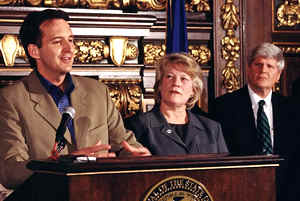 |
Following Friday morning’s news conference at the state capitol,
Pawlenty and Molnau flew separately around the state to garner support
for their plan. Photo by David Gonzalez
|
Construction of more than one billion dollars’ worth of critical highway
and bridge projects could begin as much as nine years earlier than originally
planned under a transportation financing package announced by Gov. Tim Pawlenty
and Lt. Gov./Commissioner Carol Molnau March 14. The Legislature will now consider
the proposal.
"The governor and I promised that we would address Minnesota’s extensive
backlog of highway and bridge projects," Molnau said. "Our financing
proposal provides the resource to move many of these projects forward, providing
motorists improvements in highway congestion, roadway safety and statewide mobility
in some corridors as soon as possible."
The $1.0 to $1.2 billion package calls for a mix of innovative financing options—including
bonding and leveraging federal highway funds—to accelerate several construction
projects into the 2004-09 construction seasons. Specific projects that may be
funded under the plan have not yet been named.
The financing package includes up to $550 million from new state trunk highway
bonds, which will be used to leverage the accelerated use of $550 million in
future federal highway funds. Additionally, the package invests $50 million
in metro area transit improvements (such as enhanced shoulder lanes, park-and-ride
lots and ramp meter bypasses) and $5 million in greater Minnesota transit service
capital improvements.
 |
While the governor met with news media in Rochester, Mankato and Alexandria,
the lieutenant governor addressed reporters in Duluth and Moorhead.
Photo by Maureen Talarico
|
"This is an aggressive approach to meeting our core responsibilities—roadway
safety, preservation and project construction," Molnau said.
"Given the current state budget situation, we need to be more creative
in our approach to transportation financing," she added. "While bonding
and accelerating federal funds is, admittedly, a short-term solution, Gov. Pawlenty
and I continue to be committed to finding a more-permanent, long-term solution
to transportation financing—without raising taxes."
The bond debt service will be repaid by reallocating the $42 million per year
that the department recently identified as savings in administration overhead
and other areas.
For more details about the plan, visit Mn/DOT’s transportation financing
page. Click here to read some of the
news coverage of the Pawlenty-Molnau plan.
|
back

|
 |
Snowstorm causes flurry of crashes involving state snowplows |
 |
 |
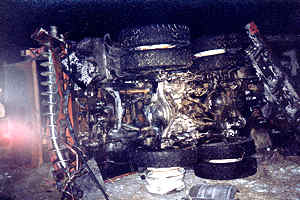 |
Nick Prudoehl, transportation generalist, District 5, St. Charles truck
station, received minor injuries after his tandem truck was rear-ended
by a semi tractor-trailer on westbound I-90 in eastern Olmsted County.
Photo by Roger Wiskow, sub-area supervisor, St. Charles truck station,
District 6
|
The snowstorm that hit Minnesota on March 8-9 dropped several inches of snow,
delayed travel and contributed to several crashes involving Mn/DOT snowplows.
The most serious incident occurred on March 8 when a plow sanding an icy patch
on westbound I-90 near the Dover exit was struck by a semi-trailer truck.
The plow operator, Nick Prodoehl, District 6 St. Charles truck station, and
the truck driver suffered only minor injuries. Both were treated and released
from the hospital. The collision drove the plow 300feet after impact until it
hit a cement ditch block, flipped on its side and slid another 100 feet.
In the Twin Cities metro area, there were at least seven incidents where snowplows
and motoristsí vehicles collided on the snowy highway system. None of the incidents
resulted in serious injury to motorists or plow operators.
Another incident also occurred in Rochester/District 6, bringing the reported
number of snowplow related crashes to nine over two days.
While the level of injuries was low compared with the number crashes, said
Mary Meinert, work zone safety communications coordinator, Office of Communications,
the potential for serious injuries or fatalities remains. She added that this
reinforces the need for motorists to use extreme caution around snowplows.
By Craig Wilkins
|
back

|
 |
Mn/DOT receives three awards for emergency management |
 |
 |
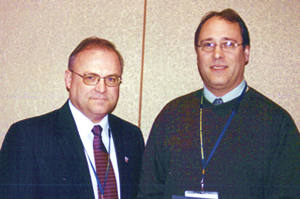 |
Jerry Rosendahl, Director of Emergency Management, presented the Outstanding
State Employee Awardto Bob Vasek, Mn/DOT Emergency Preparedness and
Response Coordinator. Photo courtesy of the Department of Public
Safety
|
Mn/DOT received Emergency Management Awards of Excellence at the Governorís
Emergency Management Conference on March 5. The awards are given to individuals
and organizations that exemplify the purpose of emergency management: to prepare
for, respond to and recover from disasters.
Outstanding State Agency
Mn/DOT was selected as the Outstanding State Agency for its "efforts that provide
not only safer transportation routes, but a better place for all Minnesotans."
Marthand Nookala, Operations, Safety and Technology Division director, accepted
the award on behalf of Mn/DOT.
Outstanding Partnership Award
Bob Prudhomme, Office of Electronic Communications, represented Mn/DOT on the
National Oceanic and Atmospheric Administration Transmitter Project Team which
also included Todd Krause, National Weather Service, and Terri Smith, Division
of Emergency Management.
These three agencies have worked together to enhance and expand the National
Oceanic Atmospheric Administration weather transmitter network in Minnesota.
Their work has included identifying needs, setting priorities, coordinating
with other program funds, working with many agencies and local units of government
and staying within the budget.
Outstanding State Employee
Bob Vasek, Mn/DOT Emergency Preparedness and Response Coordinator, was named
Outstanding State Employee for leading Mn/DOT's efforts in responding to the
needs of local government during times of disaster. The most recent example
happened during the floods of 2002, when Mn/DOT contributed resources quickly
due to Vasekís efforts.
Vasek was also recognized for his leadership in heightening employee awareness
of their role during a disaster/emergency and for understanding the emergency
management program and how Mn/DOT can contribute to it.
"This yearís recipients went that 'extra mile' and exhibited outstanding efforts
to provide support and assistance to victims, fellow responders, and the citizens
of Minnesota," said Jerry Rosendahl, the stateís Emergency Management director.
By Sonia Pitt
|
back

|
 |
McFarlin returns as assistant to commissioner |
 |
 |
Bob McFarlin, a former chief of staff and communications director with Mn/DOT,
was appointed as an assistant to the commissioner for transportation and public
affairs. In his new position, McFarlin will report to Lt.Gov./Commissioner Carol
Molnau and lead Mn/DOTís policy initiatives to further the Pawlenty/Molnau administrationís
goals for Minnesotans to travel safer, smarter and more efficiently. His appointment
began March 3.
In addition to his leadership on policy issues McFarlin will also lead the
Offices of Government Relations and Communications.
For nearly a decade during the 1990s, McFarlin served as Mn/DOTís director
of public affairs and chief of staff under former Commissioner Jim Denn.
McFarlin holds a bachelorís degree in business administration and a masterís
degree in speech communication from the University of Minnesota. He also holds
accreditation as a public relations professional.
|
back

|
 |
Community support propels start of Wadena Countyís new transit service |
 |
 |
 |
Friendly Rider buses such as the one drawn above will begin serving
customers in Wadena County this spring.
|
Backers of Wadena Countyís new Friendly Rider transit system fully expect it
to be rider-friendlyóand then some. The service will start in April to provide
greater mobility for many of the countyís residents.
The system will start operation in April with three 15-passenger, lift-equipped
buses. Service on Sundays will help more county residents to attend worship
services and community events. Residents of Wadena and places such as Menagah,
Verndale and Lost River will find it easier to obtain medical care, shop for
groceries and other necessities and to participate more fully in community life.
Grants from Mn/DOT and the county paid for new buses and for operations, according
to Paul Sailer, county social services director. Cash donations from individuals,
government, businesses and community groups helped Wadena County to raise the
needed "local match" to qualify for state transit funding. One individual, retired
farmer Walter Goedel, donated $10,000 to help get the service under way
Paul Sailer, county social services director, said widespread community support
persuaded the countyís board of commissioners to authorize the new transit service.
Without mobility, many peopleóincluding elders and people with disabilitiesócan
become increasingly dependent, often leaving the community or becoming isolated,
he said.
"The basic purpose of transit is to preserve or improve a communityís quality
of life," added John Tocho, director, Mn/DOTís Transit Program Section. "The
need to get out and move about is basic whether thatís an elderly person, a
person with a disability, a child needing a ride to an after-school activity
or a family with two jobs and one vehicle."
Goedel, 79, said his support for the services stems from his knowing that eventually
he will be unable to drive but still wish to retain a measure of independence
and mobility.
"It might sound selfish," he said, "but Iím nearly 80 and I thought if anything
was going to get moving we needed to start someplace. Even if I moved into town
Iíd still need to get to church and things and things like that."
Donna Allan, Mn/DOTís director of transit, said in addition to funding support,
Mn/DOT provides technical expertise for everything from vehicle selection and
purchasing to scheduling and route operation. When the new system begins operation,
67 of the stateís 87 counties will offer public rural transit service.
"Wadena Countyís initiating a transit service will improve the daily lives
of individuals and benefit community institutions and life," said Allan. "Mobility
is a major contributor to a healthy, vibrant community."
|
back

|
 |
Congressman presents check for Hwy 23 improvements |
 |
 |
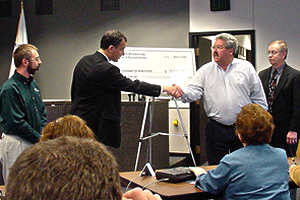 |
U.S. Rep. Mark Kennedy, District 6-Minnesota, presented the Hwy 23
task force and Mn/DOT with a $1 million check. Photo by Sandy East
|
The money arrived on March 14 to widen a portion of Hwy 23 in southwestern
Minnesota this spring, hand-delivered personally by a member of Congress. U.S.
Representative Mark Kennedy, District 6-Minnesota, presented the Highway 23
task force and Mn/DOT with a $1 million check at a ceremony celebrating the
public/private partnership that developed the project.
On hand to accept the check was Bob Dols, Highway 23 Task Force Chair. Others
in attendance were Paynesville and Spicer mayors Jeff Thompson and Bill Taylor
respectively, as well as Ken Warner, Willmar Lakes Area Chamber of Commerce.
The Hwy 23 funding comes from the Omnibus Federal Funding Bill recently approved
by Congress. The bill included funding for numerous transportation projects
in Minnesota. A portion of the bill designated $9.8 million for Greater Minnesota
highway projects, including the widening of Hwy 23 to four lanes between Willmar
and Spicer.
This shows strong federal support for the Highway 23 corridor and other greater
Minnesota transportation efforts," said Dave Trooien, district engineer,
Willmar/District 1.
Mn/DOT staff worked for several years with local governments, citizensí groups
and business owners to gain support for the project, which affects communities
such as Spicer and New London. Hwy 23 is important to a much larger region as
well, with support coming from other communities on Hwy 23 such as Marshall.
Long-range forecasts indicate heavy population growth and increased commuter
traffic.
Highway 23 has strong support from the communities all along the corridor,"
Kennedy said. "I can't emphasize how important the coalition is. There's a lot
of people pushing for the plan."
Paul Jurek, Mn/DOT construction engineer, said that crews will begin work on
Hwy 23 the first week of April if weather permits.
For more information, visit:
Willmar/District 8 news release: http://www.dot.state.mn.us/d8/newsrels/03/021903hwy23projectawarded.html
Newsline story, March 5: http://ihub.newsline/archive/03/mar/5.html
By Sandy East
|
back

|
 |
Quick response limits fuel spill from overturned tanker |
 |
 |
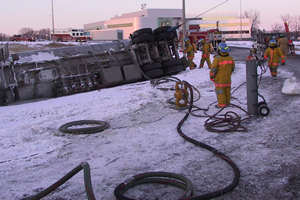 |
Roseville firefighters check leakage from an overturned fuel tanker
that crashed on Hwy 36 near the Metro Districtís Waters Edge building
on March 8. Photo by Mike Ritchie
|
A fast, well-coordinated response by Mn/DOT and other agencies on March 8 turned
a potential major fuel spill into a routine recovery operation. Thatís when
a tanker carrying 8,500 gallons of diesel fuel and gasohol rolled over on Hwy
36 in Roseville near the Metro Districtís Waters Edge Building.
The tanker crashed near a storm sewer drain and spilled about 500 gallons of
fuel into the drainage pond next to Waters Edge. State Patrol closed the highway
from 1:30 p.m. until 9:30 p.m. Once the fuel leakage was blocked and the highway
reopened, hazardous materials crew pumped the diesel fuel and alcohol to another
tanker before righting the overturned tanker.
A Metro Division Maryland Avenue truck station crew then plowed a path for
the vacuum trucker ordered by the PCA and provided traffic control until the
highway was reopened. Hazardous materials crew then drilled four holes in the
tanker, pumped the diesel fuel and gasohol to another tanker and then turned
the tanker upright.
Agencies partnering to contain and clean up the spill included the State Patrol,
Metroís Dispatch Center. Minnesota Pollution Control Agency, the Roseville Fire
Department, and Metro District-Maryland Avenue maintenance crews. Each agency
played its part smoothly.
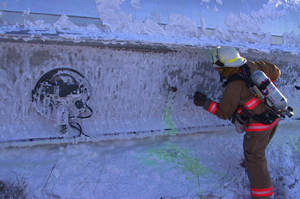 |
Fuel from this overturned tanker leaked into the drainage pond near
Waters Edge as well as into the sewer. Photo by Mike Ritchie
|
-
Metro Dispatch and the State Patrol alerted the PCA, who traced the spill.
-
The Roseville Fire Department managed the incident, stopped the initial
leakage and provided fire protection.
-
Maryland Avenue crews plowed snow to clear a path for a vacuum trucker
ordered by the PCA.
-
The hazardous materials crew transferred the fuel from the tanker and turned
it upright again.
-
Also on hand was Mike Ritchie, the hazardous materials specialist on call
from Mn/DOTís Office of Freight and Commercial Vehicle Operations.
Ritchie said the fuel recovery and transfer met all guidelines for ensuring
safety and minimizing environmental damage. As examples, he said the leakproof
manhole covers on top of the tanker did hold, thus minimizing leakage, and response
crews made sure that the aluminum-bodied tanker was completely empty before
moving it.
"If we had tried to right it full of fuel, it could have ripped open like a
Coke can," Ritchie said, adding: "The cooperative effort and our training really
paid off. Mn/DOT got there early with the right people who had the right skills
and equipment to get it done."
|
"Mn/DOT got there early with the right people who had the right skills
and equipment to get it done."
Ė Mike Ritchie
|
By Craig Wilkins
Note: To read more about this and other District stories such as the
Hwy 23 widening project in Willmar/District 8, check out the district newsletters
listed below:
.
|
back

|
 |
Steps taken to protect employees, infrastructure from potential security threats
|
 |
 |
In anticipation of the war in Iraq, Mn/DOT has put steps in place to respond
to the increased domestic threat level and has assigned staff to the stateís
Emergency Operations Center. For details please read the letter
from Lt. Gov. Molnau to all Mn/DOT employees.
|
back

|
 |
|
 |



